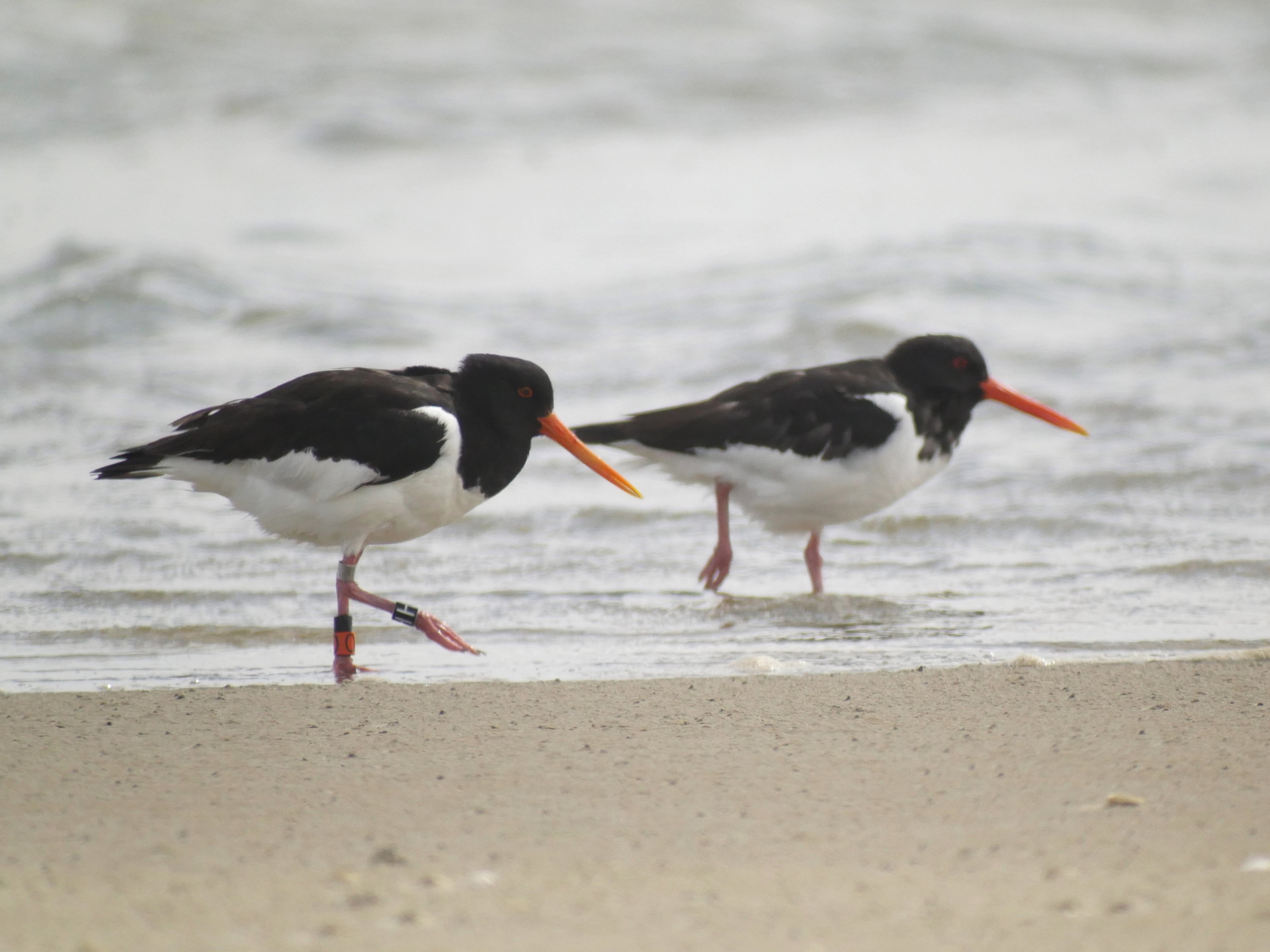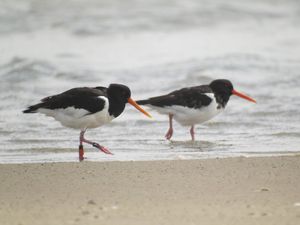 LINKED PAPER
LINKED PAPER
The hidden cost of disturbance: Eurasian Oystercatchers (Haematopus ostralegus) avoid a disturbed roost site during the tourist season. van der Kolk, H.J., Ens, B.J., Oosterbeek, K., Jongejans, E., & Van de Pol, M. 2021 Ibis. doi: 10.1111/ibi.13035 VIEW
The Wadden Sea is an important area for shorebirds to breed, winter or to refuel during migration. At the same time, the Wadden Sea is annually visited by many tourists and the area is used for many other human activities, which can cause disturbance. Disturbance is obviously visible in the field when birds have to take flight due to the presence of walkers or vehicles. However, some effects of disturbance may be hard to demonstrate in the field, for example, when birds avoid sites with high levels of human activities. Avoidance of disturbed sites is potentially harmful and can lower the carrying capacity of an area (e.g., when birds avoid certain foraging areas) or can increase daily energy expenditure (e.g., when birds avoid roost sites and have to commute further between foraging and roosting areas).
Westerse Veld and Richel as a case study
We studied Eurasian Oystercatchers (Haematopus ostralegus) in the Dutch Wadden Sea. Oystercatchers were equipped with GPS trackers, meaning that we could follow individuals in high detail both during low tide (when birds are foraging) and high tide (when birds are roosting). Our study focussed specifically on the area around Oost-Vlieland, a village on the Wadden island Vlieland. Birds that forage on mudflats near Oost-Vlieland can choose between two sites to roost at high tide: Westerseveld and Richel. Westerseveld is a frequently disturbed roost site that is located on a dike near the village (Figure 1). Since the dike is a walking trail, birds are often disturbed, especially in summer and early autumn when levels of tourism are high. Alternatively, Richel is an undisturbed deserted sandflat for which access is prohibited for walkers and boats. These two sites provide an interesting case study, since there are no other nearby roost sites and birds that forage on mudflats in this area thus have a ‘binary choice’ to roost on either Westerseveld or Richel.
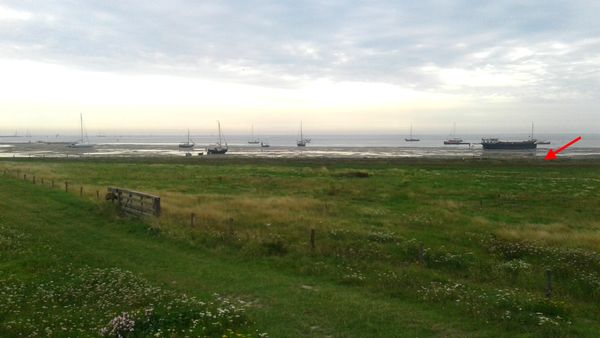
Figure 1 Westerseveld in summer. The red arrow indicates the dike which functions as a high tide roost site for Eurasian Oystercatchers but is also accessible for walkers. Additional disturbance is caused by boats that fall dry on mudflats in front of the dike, which happens especially in summer.
Avoidance is correlated with levels of tourism
The GPS data revealed that oystercatchers often chose to roost on Richel, even when they were foraging closer to Westerseveld (Figure 2). More interestingly, the probability that birds would choose to roost on Westerseveld was lower in summer and early autumn compared to winter (Figure 3, -3 hours before high tide). The probability that oystercatchers chose to roost on Westerseveld was negatively correlated with an index of tourism levels (that peaks in summer and is lowest in winter). Since tourists are often present at Westerseveld, it is likely that oystercatchers avoid Westerseveld in the tourist season due to high disturbance levels. Instead, even though they have to fly further, oystercatchers may decide to fly to Richel immediately, where also in summer no tourists are allowed.
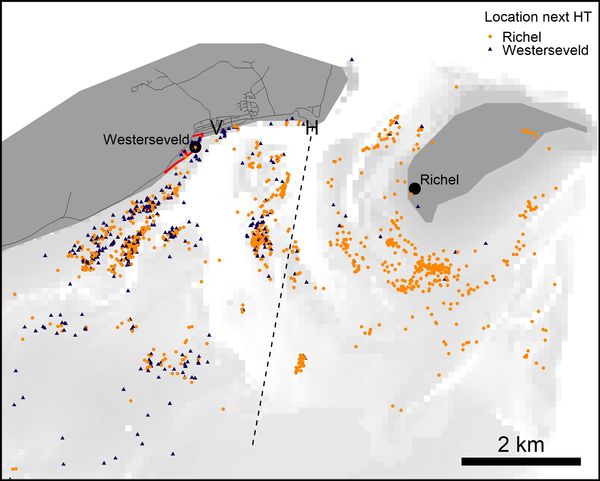
Figure 2 Map of the study area. The point show foraging locations of oystercatchers and the colour indicates which high tide roost site birds chose in the next high tide. If birds would minimize flight distance, birds that foraged west from the interrupted line would choose to roost on Westerseveld, but often birds chose to flow to Richel instead.
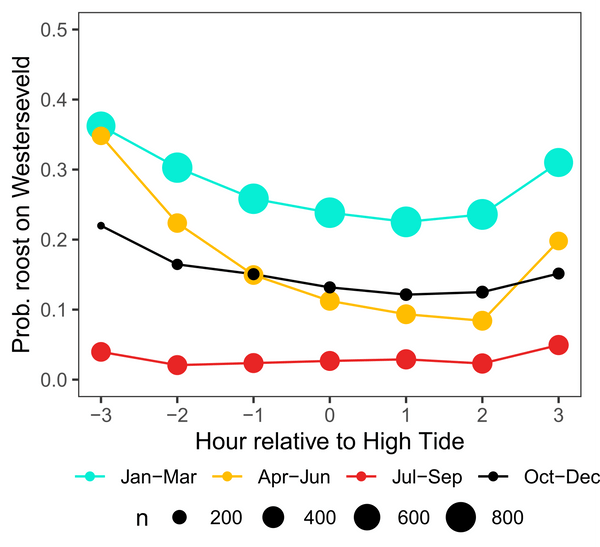
Figure 3 The probability that oystercatchers were roosting at Westerseveld (compared to the total number of Eurasian Oystercatchers present on Westerseveld and Richel), in different seasons and throughout the high tide period. For every season, the probability is shown from three hours before the moment of high tide until three hours after high tide. Note that especially in winter and spring, the number of birds present at Westerseveld decrease throughout the high tide period due to disturbance.
Avoidance is energetically costly!
Many oystercatchers forage on mudflats southwest of Westerseveld and would ideally roost at Westerseveld to minimise flight distance (Figure 2). If birds that forage here decide to roost on Richel instead, this amounts to an additional flight distance of 8 km per high tide period, which increases daily energy expenditure by 3.4%. Interestingly, this is much more than the estimated additional energy expenditure due to disturbances at high tide roost sites on Vlieland during an average high tide period (0.2-0.6%; van der Kolk et al., 2020). This highlights that avoidance of disturbed sites can be more energetically costly than ‘visible disturbance’. It is therefore important that nature managers and policy makers ensure that there are sufficient undisturbed roost sites available nearby important feeding grounds of shorebirds in intertidal areas such as the Wadden Sea.
References
van der Kolk, H., Krijgsveld, K.L., Linssen, H., Diertens, R., Dolman, D., Jans, M., Frauendorf, M., Ens, B.J. & van de Pol, M. 2020. Cumulative energetic costs of military aircraft, recreational and natural disturbance in roosting shorebirds. Animal Conservation 23: 359-372. VIEW
van der Kolk, H. 2021. Stay or fly away? Impact of human disturbance on shorebird individuals and populations. PhD thesis. Radboud University, Nijmegen, the Netherlands.
van der Kolk, H., Oosterbeek, K., Jongejans, E., Frauendorf, M., Allen, A.M., Bouten, W., Desmet, P., de Kroon, H., Ens, B.J., van de Pol, M. 2021. O_VLIELAND – Eurasian oystercatchers (Haematopus ostralegus, Haematopodidae) breeding and wintering on Vlieland (the Netherlands). Dataset. VIEW
Image credit
Top right: Eurasian Oystercatcher Haematopus ostralegus © Henk-Jan van der Kolk.
If you want to write about your research in #theBOUblog, then please see here.


